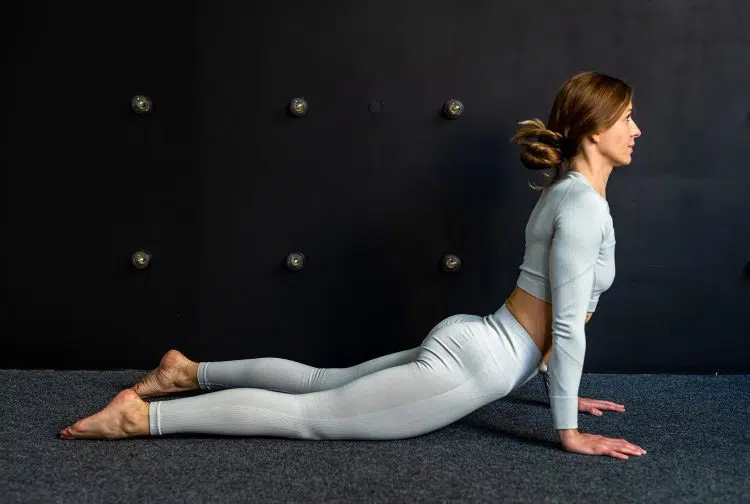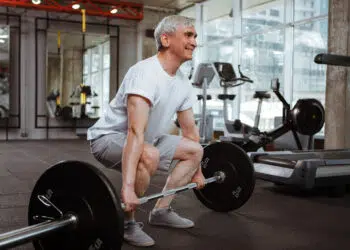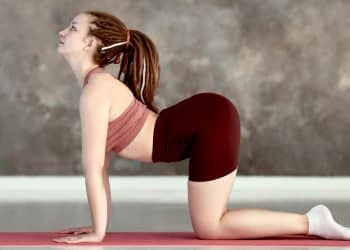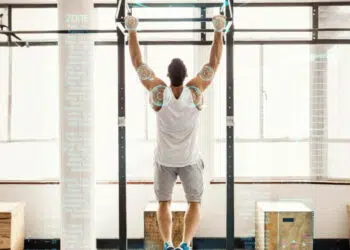While it might sound like alarmist hyperbole, medical and fitness experts agree that sitting is bad for your health. How bad? Research suggests that prolonged sitting may be as unhealthy as smoking (1).
Sitting too much, which goes hand in hand with a sedentary lifestyle, is linked to the following health risks (2):
- Weight gain
- Obesity
- Metabolic syndrome
- Type II diabetes
- Poor posture
- Back pain
- Cardiovascular disease
- Heart attack
- Increased blood pressure
- Stroke
- Osteoporosis
- Dementia
- Alzheimer’s disease
- Depression
However, where smoking is a matter of personal choice, sitting is often unavoidable. A large percentage of people sit for work, and most forms of mechanized transport involve sitting. The majority of us spend our leisure time sitting, too.
After all, who stands to watch TV, right?!
As a veteran personal trainer, I often work with clients who sit for many hours per day. Our workouts help counteract some of the harmful effects of sitting, and I always provide advice on how to sit less and move more.
In addition, I give most of my clients a list of five stretches to help improve their posture, ward off lower back pain, and restore the mobility that sitting degrades.
Level Up Your Fitness: Join our 💪 strong community in Fitness Volt Newsletter. Get daily inspiration, expert-backed workouts, nutrition tips, the latest in strength sports, and the support you need to reach your goals. Subscribe for free!
In this article, I share those stretches with you. Do these stretches daily if you spend a lot of time sitting – your body will thank you!
Read also: How Sitting Is Bad for You and What to Do About It
The 5 Stretches Every Desk Dweller Needs
While there are hundreds of stretches to choose from, the five listed below will provide the greatest bang for your buck while helping to undo the muscle-shortening effects of prolonged sitting.
Do these exercises to break up long periods of sitting, at the end of the day to lengthen and relax your muscles, or any time you feel tight or sore.
1. Standing Single-Leg Hamstring Stretch
Sitting puts your hamstrings in a flexed position, leading to muscle shortening and tightness. Consequently, if you sit a lot, the chances are you have tight hamstrings. The hamstrings cross your hip and knee joint and, as such, affect both these critical joints. Tight hamstrings can also contribute to lower back pain (3).
A lot of people find stretching their hamstrings uncomfortable. In my experience, this is often due to their choice of exercise. The standing single-leg hamstring stretch is a gentle option that’s perfect for those of us who lack the flexibility of an elite gymnast!
Steps:
- Keeping your leg straight, place the heel of one foot on a low stool, step, or bench. Pull your toe gently up toward your shin.
- Bend your supporting leg slightly for balance.
- Keeping your chest up, hinge from the hips, and lean forward until you feel a mild stretch in your hamstring.
- Hold for 20-60 seconds.
- Slowly ease out of the stretch and then change sides.
- Repeat with the other leg.
Tips:
- Avoid rounding your lower back. Doing so reduces the stretch in your hamstrings and increases your risk of back pain.
- Place your hands lightly on your upper thigh if you wish. However, do not press down on your extended knee.
- Keep your neck long and your head in line with your spine. No slouching!
2. Kneeling Hip Flexor Stretch
If there was an award for the hardest working skeletal muscle in the human body, it should probably go to the hip flexors. There are several muscles that flex the hips – the iliacus, psoas major, and rectus femoris.
These muscles are involved in most abs exercises and also play a critical role in walking, running, and many other common movements. Given how much work they do, it’s no wonder that the hip flexors are often tight.
But, to add insult to injury, sitting places the hip flexors in a shortened position, so it’s no wonder that most people have tight hips. Shortened hip flexors can affect posture, leading to a rounded lower back.
Steps:
- Step forward, bend your legs, and lower your rearmost knee to the floor. Your knees and hips should form right angles.
- Place your hands lightly on your front thigh for balance.
- Contract your glutes, engage your core, and tilt your tailbone under.
- Gently ease your hips forward until you feel a stretch in the front of your hip.
- Hold for 20-60 seconds.
- Slowly ease out of the stretch and then change sides.
- Repeat with the other leg.
Tips:
- Kneel on a foam pad or folded mat for comfort.
- Take care not to hyperextend your hip or spine during this exercise, as doing so makes it less effective and more likely to cause injury.
- Keep your torso upright – do not lean forward.
3. Prone Sphynx
While it is possible to sit in good posture, i.e., without slouching, most people hunch over their desks or keyboards. This position puts your abs in a shortened position while simultaneously stretching the muscles and ligaments of the lower back. As a result, people who sit a lot often look like they’re sitting even when they try to stand up straight.
The prone sphynx provides a gentle way to extend your spine and lengthen your abs. It also opens your chest, which enhances breathing and helps lower stress levels. In other words, this is the perfect exercise for all hard-working desk warriors.
Steps:
Level Up Your Fitness: Join our 💪 strong community in Fitness Volt Newsletter. Get daily inspiration, expert-backed workouts, nutrition tips, the latest in strength sports, and the support you need to reach your goals. Subscribe for free!
- Lie on your front.
- Raise your chest and shoulders and support your weight on your outstretched forearms.
- Push your shoulders down and back.
- Lift your chest, arch your back, and look upward.
- Hold this position for 20-60 seconds and then relax.
Tips:
- Keep your hips pressed into the floor throughout.
- Place a folded exercise mat or foam pad under your hips for comfort.
- Extend your arms to raise your upper body further if you need a deeper stretch:
4. Supine Foam Roller Thoracic Extension
When thinking about your back, it’s all too easy to focus on your lumbar or lower spine. After all, this is where most back pain occurs. However, prolonged sitting can affect your upper back, especially the thoracic or T-spine.
The T-spine is naturally rounded, but sitting exaggerates the curve and can lead to a hunched appearance if ignored. Foam rolling is one of the best ways to release and realign your thoracic spine.
Don’t be alarmed if you hear or feel some clicks when doing this exercise for the first few times. That’s just your vertebrae moving back into their correct position. You should experience fewer clicks as your thoracic spine alignment improves.
Steps:
- Lie on the floor and place a foam roller horizontally under your upper back.
- Place your hands behind your neck and point your elbows toward the ceiling.
- Brace your core.
- Gently arch your upper back around the roller, pointing your elbows backward as you extend your spine.
- Hold this position for 20-60 seconds.
Tips:
- Keep your hips and butt pressed firmly on the floor.
- No foam roller? Try wrapping a water bottle in a towel and using that instead.
- Move the roller up and down your thoracic spine to target specific areas of tightness. However, do not roll your lower spine or neck, which could cause injuries.
5. Doorway Chest Stretch
Most anti-sitting exercise lists focus on the lower body. This makes a certain amount of sense, given how much sitting can hurt your legs and lower back. However, your upper body is not immune to the effects of sitting, and tight chest muscles are as common a problem as shortened hip flexors and hypertonic hamstrings.
The doorway chest stretch is one of the best upper body stretches I know. It’s comfortable, practical, and easy to modify. I try to do this exercise whenever I pass through an open doorway at home, which helps me maintain good posture despite spending a lot of time working at my desk.
Steps:
- Stand in an open doorway.
- Adopt a staggered stance for balance.
- Raise your arms and place your forearms on the vertical doorframe so your elbows are roughly level with your shoulders. Your palms should be flat.
- Gently press your upper body between your arms to stretch your chest.
- Hold for 20-60 seconds and then relax.
Tips:
- Lead with your chest while doing this exercise. Avoid thrusting your head forward.
- Raise or lower your elbows slightly to affect different parts of your pecs.
- No doorway? No problem! You can also do this exercise in the corner of almost any room:
Stretching Guidelines
While doing any of these exercises will help lessen the harmful effects of too much sitting, you’ll experience better results if you do them in conjunction with a few simple stretching guidelines:
Move in and out of each stretch slowly and smoothly – lengthening a muscle too quickly can trigger the stretch-shortening reflex. The SSR makes your muscles contract rather than lengthen. Moving slowly into each stretch will produce better results while lowering your risk of injury.
Stretch further as your muscles relax – you should feel your muscles relax after 15-20 seconds. Stretch a little deeper when this happens to get more from each exercise.
Do not hold your breath – holding your breath triggers the sympathetic or stress nervous system, increasing muscle tension and negating many of the benefits of stretching. Breathe slowly and deeply to activate the parasympathetic nervous system and encourage your muscles to relax.
Back off if you experience any muscle shaking or burning – there is a fine line between a deep but beneficial stretch and overextending and injuring your joints or muscles. Ease off if your muscles start to shake or you feel burning in the target muscles. These are reliable indicators that you are doing more harm than good.
Stretch little and often – the more often you can stretch, the more you’ll ward off or reverse the muscle-tightening effects of prolonged sitting. Try to stretch a few times each day, even if it’s just for a couple of minutes. You don’t have to do all five stretches every time. Instead, do 1-2 for a minute each and then do the other exercises later.
Related: 7 Stretching Mistakes Everyone Makes (And How to Avoid Them)
Conclusion
Prolonged sitting is hard to avoid. Work, transport, and leisure all involve a lot of sitting. In addition, many exercises and workouts are performed while seated. Unfortunately, while sitting is part and parcel of daily life, it can also be harmful. Too much could even shorten your life.
One way to reduce the impact of sitting on your health is to walk more. Just 30 minutes of walking a day will reduce the damaging effects of prolonged sitting. A daily dose of 10,000 steps will lower the risk even more.
Daily stretching is another way to ward off the harmful effects of sitting. You don’t need to do a lot of different stretches to maintain your flexibility. In fact, you can get great results from five simple exercises.
Do these exercises daily to help reduce the musculoskeletal effects of prolonged sitting. I’ve done them twice while writing this article!
Read Next: How Much Stretching Is Too Much? The Science Behind Overstretching and Safe Stretching Practices
References:
- Baddeley B, Sornalingam S, Cooper M. Sitting is the new smoking: where do we stand? Br J Gen Pract. 2016 May;66(646):258. doi: 10.3399/bjgp16X685009. PMID: 27127279; PMCID: PMC4838429.
- Wilmot EG, Edwardson CL, Achana FA, Davies MJ, Gorely T, Gray LJ, Khunti K, Yates T, Biddle SJ. Sedentary time in adults and the association with diabetes, cardiovascular disease, and death: systematic review and meta-analysis. Diabetologia. 2012 Nov;55(11):2895-905. doi: 10.1007/s00125-012-2677-z. Epub 2012 Aug 14. Erratum in: Diabetologia. 2013 Apr;56(4):942-3. PMID: 22890825.
- Jandre Reis FJ, Macedo AR. Influence of Hamstring Tightness in Pelvic, Lumbar and Trunk Range of Motion in Low Back Pain and Asymptomatic Volunteers during Forward Bending. Asian Spine J. 2015 Aug;9(4):535-40. doi: 10.4184/asj.2015.9.4.535. Epub 2015 Jul 28. PMID: 26240711; PMCID: PMC4522442.









